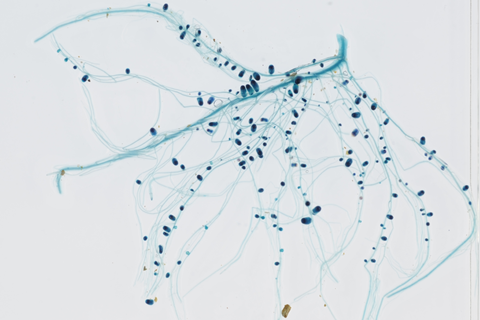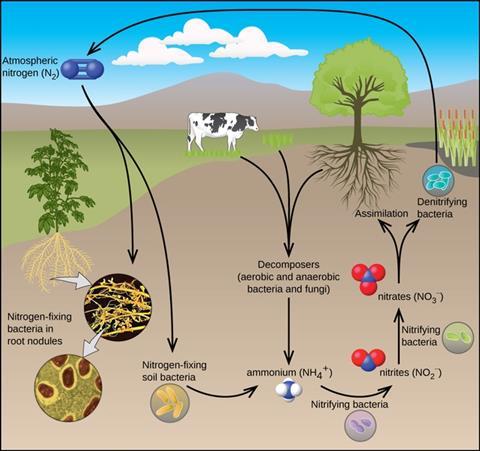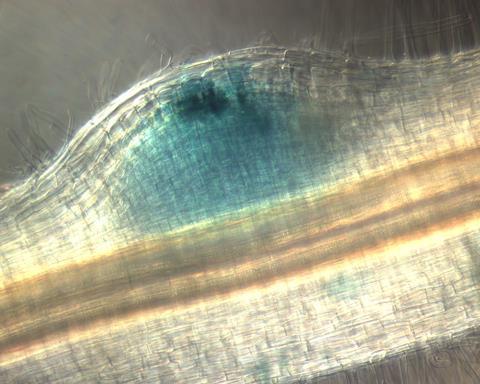Scientists have lifted the lid on the miniature world of soil microbes, revealing how they sense and move in response to a variety of chemical and nutrient signals at various stages of symbiosis with legume plants.
The team at the University of Oxford published their findings in a paper, ’The motility and chemosensory systems of Rhizobium leguminosarum, their role in symbiosis, and link to PTSNtr regulation’, which has recently appeared in Environmental Microbiology, an Applied Microbiology International publication.

The work was carried out by Samuel Aroney, a PhD student co-supervised by Dr Carmen Sánchez Cañizares together with Prof. Phil Poole, and with help from Francesco Pini and Celia Kessler in the Department of Biology.
Sense and respond
“We discovered that soil microbes - rhizobia - sense (via chemotaxis systems) and respond (through motility) to a variety of chemical signals and nutrients at various stages of symbiosis with legume plants. We also show the impact of these motility and chemotaxis systems across the symbiotic cycle, and how they apply a brake on motility in response to chemicals that are fed to the microbes by the plant within nodules,” corresponding author Dr Carmen Sánchez Cañizares said.
”The future of agriculture faces the challenge of providing the expanded population with a sustainable and secure supply of food by minimising both the land and the chemical inputs. In this context, microbial-based technologies can contribute to globally important environmental and agricultural processes.

“Thus, our research is focused on soil microbes. They influence plant growth, soil health, and resource use efficiency. When selected microbes are applied as bioinoculants, they improve plant nutritional status and protect against biotic and abiotic stresses.
“Unravelling the net result of tightly regulated microbial activities is key to understanding microbe-microbe and plant-microbe interactions to ensure an optimal cell function, and this applies to key processes for soil bacteria such as motility and chemotaxis and their link to central metabolism.”
Power of chemoreceptors
The paper shows how rhizobia typify soil bacteria by having a high number of chemoreceptors (chemical receptors used to control bacterial movement), enabling sensing and targeting of a wide range of potential energy sources.
The team also examined the complexities of control of motility, showing links to regulation exerted by PTSNtr and between central metabolic pathways and cell motility. Surprisingly, chemicals from central carbon metabolism (the TCA cycle), which are often fed to symbiotic bacteria by plants, cause the bacteria to completely stop moving.

Rhizobia form symbioses with legumes within root growths called nodules. Using the Rhizobium-legume symbiosis as a model system, the team demonstrated the importance of motility and chemotaxis on bacterial competition, nodulation dynamics and development, highlighting the importance of these mechanisms in a free-living cell in the rhizosphere (region of soil surrounding a plant root with enhanced microbial activity and increased concentration of root exudates), and at different stages of symbiosis.
Chemotaxis genes and motility
The authors also show that the primary set of chemotaxis genes (Che1 cluster), in coordination with flagella, has a role in free-living bacterial motility and competition to form nodules, while the secondary set (Che2 cluster) may influence bacteroid development and nodule maturation, rather than directly regulating motility.
“Rhizobia are soil bacteria well-known in agriculture for establishing a beneficial interaction with legumes, as they supply nitrogen to these important crops (nitrogen is one of the primary limiting nutrients for plant growth and crop productivity),” explained Dr Sánchez Cañizares.

“In the soil, they move towards the plant root surface through motility and chemotaxis (swimming to the roots), where they engage in a molecular dialogue with the plant and colonize the root by complex signalling and attraction processes. If successful, this recognition between the two partners enables their entrance into the root hair, forming a nodule where they differentiate into nitrogen-fixing bacteroids.
Crucial processes
“In this context, motility and chemotaxis are crucial processes for soil bacteria and plant-microbe interactions. Soil is a challenging environment for microbial motility, with the rhizosphere a critical niche for plant–microbe interactions. These interactions are strongly influenced by chemically complex root exudates with bacterial chemotaxis to these exudates dependent on different chemoreceptors.
”The effectiveness of rhizobial inoculants in the field relies on their motility and dispersal through soil. Therefore, how soil bacteria respond to nutrients and influence their symbiotic behaviour is of crucial importance for their survival and adaptation both in soil and when interacting with their plant hosts. Understanding the molecular processes responsible for the establishment of this symbiosis will allow us to design efficient bioinoculants that lead to sustainable crop yields and a future positive impact on the environment.”
Investigating chemoreceptors
Further work could investigate the many chemoreceptors present in rhizobia to find their cognate signals and also key receptors that target specific legumes (particularly important crops), PhD student Samuel Aroney said.
“This could enable the creation of rhizobial inoculants with better soil survival that also strongly associate with targeted crop plants. In addition, the role of the secondary chemotaxis system (Che2) could be examined in more detail to determine the molecular mechanisms that explains why the system is important and what it is doing within symbiosis,” he said.
The work was supported by grants from the BBSRC and The Leverhulme Trust led by Prof. Philip Poole, the Doctoral Training Partnership at Oxford, and a University Research Fellowship by The Royal Society awarded to Dr Sánchez Cañizares.
‘The motility and chemosensory systems of Rhizobium leguminosarum, their role in symbiosis, and link to PTSNtr regulation’ appeared in Environmental Microbiology, an Applied Microbiology International publication.







No comments yet